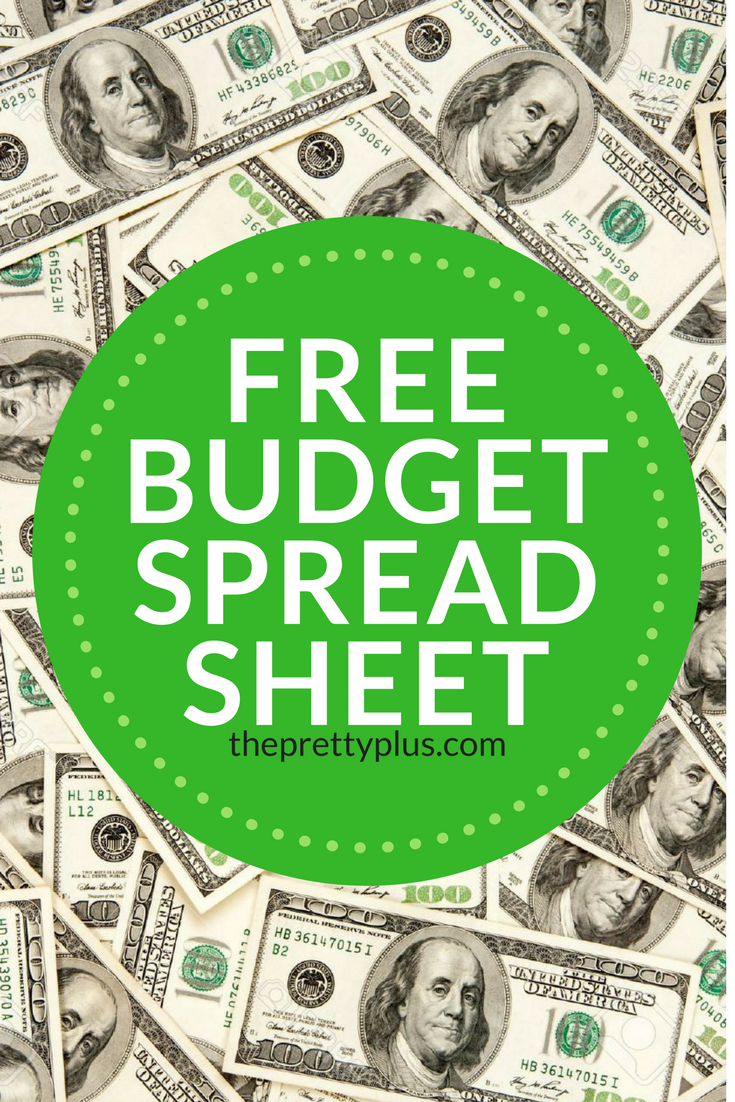Please see the new post with updated sheet & instructions.
THE PRETTY PLUS BUDGET SPREADSHEET
This particular blog is one I have gotten quite a few requests for. Get a snack guys, because this is a long one, but I PROMISE it’s worth the read! It’s all about my Budget Spreadsheet. This is the spreadsheet I’ve been working HARD to perfect for the last 3 months, and I’ve waited to share it with you because I keep making edits. The truth is, I don’t think there will be a time that it’s PERFECTED, because things change, but I think it’s a pretty good basis for you to go off of at this point.
Before I go over some of the points and explain things, here is the link to the Budget Spreadsheet. You can only VIEW this, not edit. So go to the top left corner, press FILE, then press MAKE A COPY. On that copy, you can begin to input your own numbers and make the spreadsheet your own. Go ahead, DO IT! You won’t regret it!!
GOALS FOR THIS BLOG POST:
-
Figure out where you are spending your money.
-
Set budgets and have a surefire way of staying on track.
-
Better track and control your excess money to pay off debts.
-
Set yourself up for optimal savings in the future.
Another thing to note is that I used numbers that were VERY similar to our own budgeting numbers, but not exactly. Everyone has quirks. You may have more or less debt. You could have more kids, no animals, more car payments, no subscription fees…whatever your things are, put them in there! Take things out that don’t make sense for you. Add things you pay for and need.
ASSETS
This is where you are going to input your income, and all the money you have in the bank. We have pretty predictable checks, so we fill the estimated amount in ahead of time, then if we are over or under for any reason (bonuses, less hours worked, etc.,) we just subtract or add the amount in overages. We notate that we have money going to our 401k accounts from each check as well. If we have any other income that comes in (tax check, money from a friend, etc. we add this in the OTHER category. The bottom right number in green is the total income we have for the month.
If you see off to the side, we have amounts sitting there with SAV next to it? That is the amount that I transfer each week to our sinking fund. We just take the amount the sinking fund equals up to for the month, divide by the number of paychecks, and send it to that account little by little. We will get into Sinking Funds in just a few!
We use 3 accounts to keep our finances straight. We put our checks into a main checking account, which we pay our bills out of as well. We put our Sinking Fund into another checking account, which we use for any expenses coming out of those categories (which, again, we will learn about in a few points!) Our third account is savings, in which we have excess money for emergencies, things we are saving for, and some transitional things. You can run your accounts how you wish, but this works for us! It makes sense in my mind, but do what makes sense for you and your family.
EXPENSES
Our expenses are pretty self explanatory. I would say this is where you will be able to do the most reflection upon WHERE you are spending your money and where you want to be putting your money. For us, we have standard bills and groceries that take up a bulk of our income. We were spending WAY TOO MUCH on food, so we are sticking to a grocery budget that’s pretty strict, and we have made our restaurant and entertainment budget low, so we look for things we can do for free and eat from home to cut costs back.
It’s hard! It takes a lot of dedication, but our end goal is to save optimal money in our month to be able to apply the excess to our debts and build up a hefty savings. It’s good to know where your money is going so you can crack down and stop unnecessary spending!
EXPENSES BROKEN DOWN
We have broken down those expenses we have monthly and put them all into their own charts. We track the dates and amounts for each expense in the Groceries, Restaurant, Entertainment, Gas, Animals, and Child categories. (We have a special savings situation that rounds up all our debits and puts the excess in our savings accounts, so we put them down as rounded up! I love this for extra “piggy bank” savings AND for ease of tracking as well!)
I really like to be able to see how often we’re getting gas, how often and how much I am spending on groceries and WHERE, and I think it’s just smart to keep track of these things closely so you don’t get crazy in your budget! It’s easy to underestimate your spending. I wish it were easier to overestimate, right?!
SINKING FUNDS
Now, sinking funds are something I have talked about a few times in this post now, but I wanted to properly explain. Sinking funds are accounts that may not be monthly charges, but they are periodic needs that you will have. We choose to put money into specific sinking funds monthly to reduce the amount of random charges that will come up as a “surprise.” When we have to make a purchase that falls into these categories, we just subtract the amount from these “mini” accounts instead of wondering where the funds will come from or having to choose between paying a bill and making an important repair or purchase.
Sinking Funds will really be set up per your own family’s needs. Go back through your finances or look at your life and think of expenses you have that don’t fall into your regular monthly spending. Below are some sinking fund ideas to get you started, beginning with the ones we have added to our expenses:
SINKING FUND EXAMPLES
- Insurance– We save all year to pay our insurance premiums up front to save cost and reduce the monthly bill!
- Car Maintenance– We both have pretty new cars, but we need routine oil changes and have some minor issues every now and then. If you have an older car and don’t make a payment, I suggest putting more aside!
- House Maintenance
- Gift-Giving– This goes for all gifts we give others, including Christmas, Birthdays, Baby Showers, etc. We actually have a spreadsheet that shows how much we spend per person per event, and we are doing our best to stay on track with that. Based off that spreadsheet, we have come up with an amount to put away monthly.
- Holiday Events– We do Friendsgiving every year, so I like to put aside money for that instead of taking the hit all in the holiday month. If you host a Christmas or other event, then you can save year-round and reduce the holiday stress!
- Pets– You never know what’s going to come up with your pets. We just had a flea outbreak, so we had to get flea medicine, but the amount we put away can be for yearly checkups and more!
- Medical– This can be used for co-pays, medication, etc. If you have ongoing medical issues, you may want to up this amount, but my husband and I are generally healthy and low maintenance, so we just add a bit for now!
- Vacation/Travel– We love a good road trip! Right now the budgeting is tight, so we have a minimal amount being put in this sinking fund, but once our debt it paid off, we will begin putting more into the fund when we decide on a vacation!
- Couples’ Fund– This fund goes to gifts for each other as well as Anniversary, Birthday, and Valentine’s Day celebrations!
OTHER IDEAS
- Wedding
- Cosmetic
- House Down Payment
- Car Down Payment
- College Tuition
- Children’s Savings
- Miscellanious
- Utilities
- Education Fees
- Major Purchase (Computer, TV, Fences, etc.)
DEBT TRACKING
We keep track of each debt, but our most offensive debt is our credit card debt! We have a few cards with some big ole’ balances with leftover from our wedding (and before) that we are working to pay off. We keep track of each card, our house & car, and then medical bills since we make payments on those. To the left, we put our minimum payments for each thing (that create the minimum cc payment in the expenses.)
On the right, we have our debt tracked to see how we are paying them down per month. It’s pretty encouraging to see the numbers go down. We follow the Dave Ramsey snowball idea, and are working to pay off our lowest balance FIRST and move on from there. So when we have our SURPLUS money from the expense tracking portion, we can put it all toward paying down a card!
MORE TO COME
This is all a LOT to break down. If you need me to go into further detail, I will be happy to break all these down into individual emails. On Sinking Funds alone, I could go on for thousands more words! I also have examples of how I track the spending and amounts inside our Sinking Funds and how I calculate our Gifting Guidelines!
I’d love to hear how you budget, but if you try my spreadsheet, let me know how it goes!













This was such a helpful post! I’m really trying to get my budget in order. Thanks so much <3
–Thanks, Maya! Hope this helps!
This was super helpful! I really needed this!
–Thanks, Catherine! Glad I could help!
We’re working really hard on this right now. We had a certain way of spending at our last home/jobs and had continued that way with our new situation which didn’t add up. Thank you for posting this budget breakdown and tips!
–Yes, you’ve got to make adjustments for life changes! Hope these hints help!
Super helpful post for the budget challenged ?? So many great pointers and tips! Thank you
–Thanks, Amanda! Glad you found the post helpful!
We’ve used a budget spreadsheet for about 10 years now and are always trying to find new ways to update it. These are FABULOUS tips – thank you!!